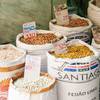General
Transport
People
Accomodation
Food & Drink
 What is the local food like in Portugal?
What is the local food like in Portugal?
 How much does the food cost?
How much does the food cost?
 What are some places to eat?
What are some places to eat?
 What local dishes to try in Portugal?
What local dishes to try in Portugal?
 Can I drink tap water in Portugal?
Can I drink tap water in Portugal?
 What soft drinks are available?
What soft drinks are available?
 Is there a coffee and tea culture in Portugal?
Is there a coffee and tea culture in Portugal?
 What alcoholic drinks to try while in Portugal?
What alcoholic drinks to try while in Portugal?
 What are the restrictions regarding alcohol consumption?
What are the restrictions regarding alcohol consumption?
 Where to buy alcohol in Portugal and how much does it cost?
Where to buy alcohol in Portugal and how much does it cost?
Sightseeing
Legal
Money
Safety & Health
Family travel

What can I eat in Portugal as a vegetarian?
Unfortunately, the Portuguese vegetarian options are quite limited as most of the food includes some kind of meat or seafood due to the country’s location. However there are still some delicious Portuguese vegetarian dishes you should try during your visit!
Caldo Verde. Portuguese often serve soups as precursors to the main meal or as a late supper, the majority of which are vegetarian. The “green broth” transforms simple ingredients into something extraordinary in what many consider the country’s national dish. This healthy and hearty soup combines potatoes, collard/kale, olive oil, onion, garlic and salt into a surprisingly flavorful dish. Many chefs add linguica or chourico sausage toward the end of cooking, but vegetarians can skip this step (or ask the chef to).
Migas. Broa takes another form in migas, literally translated as breadcrumbs. This bread soup is prepared by cutting tough, heavy country bread into small pieces, sprinkling them with water and pan-frying with olive oil and garlic to create crunchy, flavorful breadcrumbs. The base of this stew and other ingredients varies regionally. Centrally located Beira tends to use a cornbread base with cooked kale, beans and rice. The Southern Alentejo region uses a wheat breadcrumb base with wild asparagus, tomato, red pepper paste, fresh coriander and pork meat drippings. Potatoes replace breadcrumbs in Alentejo’s Migas de Batata.
Açorda. A typical peasant food from Alentejo, açorda is crafted out of day-old bread and mashed with garlic, bits of coriander, olive oil, vinegar and poached eggs. The Alentejo is Portugal’s largest region, an area brimming with fields, farms and vineyards. Here, locals are mainly farm labourers, who would make açorda because of its cheap ingredients that could be customised with anything else they had on hand: the wealthier the family, the richer the açorda. Along the coast, shrimp and other seafood can be added to the dish, while inland, cooks are more likely to throw in hunks of wild game.
Portuguese “Orange” Soups. In contrast to caldo verde, many fall/winter soups feature an orange base. Chefs can chose from pureed carrot, pumpkin, potato and onion as a base to form a thick, orange soup. Often roasted garlic and sweet sautéed onions compliment the “sweet” richness of the squash. To build upon the base, add the namesake-cooked greens such as nabiças (kale), espinafres (spinach), feijão verde (long green string beans) or couve (cabbage) and feijão (kidney beans).
Quijadas/pastéis de feijão. In Portugal, the omnipresent bakeries often overshadow the availability of restaurants. Choosing just one to feature, from the land of pastry lovers, is a challenge but many consider this 19th century “bean patisserie cake” as the country’s quintessential dessert. Developed in the city of Torres Vedras, a slightly odd-looking cake contains creamy, phenomenal flavor. With endless variations, this savory, buttery dessert can feature white or red bean puree in an egg-y filling. The doughy dessert is baked to golden brown, sprinkled with powdered sugar and sometimes topped with almonds. Try it at teatime with an energizing cup of Earl Grey or a shot of espresso.

What can I bring home from Portugal?

What type of adapter do I need for the outlets?

How do I use ATMs in Portugal?

Is there a coffee and tea culture in Portugal?

How to get to Portugal?
